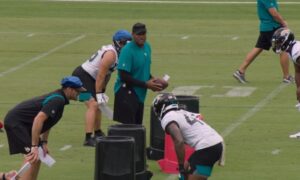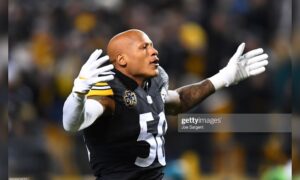It’s said a draft class can’t be fully graded until at least three years after the picks are made. That’s why after submitting grades for every Pittsburgh Steelers pick made in 2021, I began going back through and grading previous Steeler draft classes beginning with 2018. Today begins the fifth class in that exercise, with the Steelers’ first-round pick in the 2014 NFL Draft: Ryan Shazier, an inside linebacker from Ohio State.
This exercise follows the six viewpoints (listed below) for examining and re-grading a pick. Each of the first five viewpoints gets examined and assigned a letter grade, before taking that analysis and combining it into a final letter grade. Those five viewpoints comprise much of what goes into the draft grades consumed by so many every year after the draft.
Steelers’ Career: What did the player contribute to the team that drafted him?
NFL Career: Did the player make the pick look better in hindsight after leaving Pittsburgh?
Pick Value: Did the player outperform his draft slot? Did he fail to live up to the pick used on him?
Positional Value: Was the player the best player remaining at his specific position in the draft?
Other Options: Did any players go during the next round that were better selections?
Overall Grade: A final mark to denote whether the selection was an overall positive one, or one better spent elsewhere.
Each factor in a retrospective doesn’t apply evenly to every pick made; consider the grades weighted. For example, to return a high grade in pick value, a first-round pick should have a long and impactful career, while a later-round pick needs only a couple seasons as a back-up or modest contributor to be worth the selection used on him.
Some factors are universal, though. Whether picked first overall or 259th, there will always be other options on the board to compare the player to, and steals and reaches can come from any place in the draft.
Round 1, Pick 15: Ryan Shazier, ILB, Ohio State
STEELERS & NFL CAREER: A
An off-the charts athlete, ran an incredible sub-4.4 40-yard dash, and was a sideline-to-sideline tackling star at Ohio State. Ryan Shazier checked every box the Steelers wanted in a dream inside linebacker to pair with a Lawrence Timmons in his prime, which is why with the team’s earliest first-round pick since drafting Timmons in 2007, the Steelers selected him one pick before the Dallas Cowboys could. Instantly, Pittsburgh had its long-term tandem to set the tone and captain the defense, though it didn’t start out so smoothly.
As a rookie, Shazier battled through multiple injuries to appear in nine games and start five, serving when healthy as a preferred option to fellow young linebackers Sean Spence and Vince Williams. The complete breakout had to wait a season, with the rookie recording only 36 tackles and two for a loss. But the breakout arrived immediately in 2015, as Shazier set or came close to what would be career-best totals across the board while starting 12 games for the Steelers. He finished with 87 tackles, a career-best 10 tackles for a loss and eight quarterback hits, had 3.5 sacks, forced two fumbles, and defensed four passes. In all but the sacks and hits, Shazier finished in the top two on the roster.
Matching his numbers across the board in this third season as a starter (second complete season), Shazier took one step further for his career: Making his first Pro Bowl. He had another 87-tackle season, with nine for a loss, had 3.5 sacks and seven QB hits, forced a career-high three fumbles, and defensed nine passes. Like the year prior, an injury forced Shazier to miss some games earlier in the season, but he continued to assume more responsibility as the leader of the defense, after earning the green dot as the lead communicator on the team’s defense in 2015.
Shazier was off to a career year in 2017, fully becoming the Steelers’ defensive leader after Timmons signed with Miami, and avoiding an early-season injury for the first time. In the team’s first 12 games, he had already set a new career-high with 89 tackles (and 68 solo stops), with 11 passes defensed, and his performance was already enough to secure his second Pro Bowl appearance.
But no one could at all prepare for what happened in the team’s 12th game that season. Making a tackle against the Cincinnati Bengals, Shazier suffered a spinal contusion that left him unable to use his legs. The injury was the first of such severity since Kevin Everett of the Buffalo Bills in 2005. It resulted in Shazier requiring surgery to stabilize his spine, and eventually ended his playing career after four seasons.
Shazier’s story did not end there, though, and deserves to be told. Given a 20 percent chance to ever walk again, Shazier defied the odds to recover his mobility. In the years after that injury, he danced at his own wedding. He walked across the stage at the 2018 NFL Draft to announce the Steelers’ first-round pick. He remained connected to the team throughout his rehab and recovery, inspiring his teammates and helping however he could. And last year, Shazier launched the Ryan Shazier Fund for Spinal Rehabilitation, a foundation created to assist those suffering from similar injuries and their families. Shazier has become an inspiration to the entire NFL community, and created an outstanding second act for himself off the field.
For the purposes of grading this retrospective, his four seasons on the field for the Steelers developed from solid to outstanding, with Shazier becoming the exact type of player the franchise hoped for when selecting him 15th overall.
PICK VALUE: A
Pittsburgh rarely drafts this high in the first round, raising the stakes of getting the pick right. Selecting 15th, the Steelers wanted the perfect linebacker for their defense, and a true leader of the unit. That is exactly what they got over four seasons from Shazier, who played like a sure-fire first-rounder during the final three seasons of his time in the NFL. In any re-draft of the 2014 class, Shazier would go just as early, and could challenge Anthony Barr as the top linebacker (not counting edge rushers) off the board.
POSITIONAL VALUE: A
The 2014 draft was an outstanding class for any teams in need of a middle linebacker, one of the deepest pools in recent years to find a productive NFL player. Shazier and C.J. Mosley headlined the class, with Mosley going two picks below Shazier to the Baltimore Ravens. He made Pro Bowls four of his first five seasons, and earned the biggest contract for an inside linebacker in NFL history with the New York Jets.
Those two earned the premium picks, but weren’t the only ones to star at some point. Two others went in the middle rounds and had short-lived but outstanding careers. Drafted 144th by Jacksonville, Telvin Smith never had fewer than 100 tackles in a season, averaged almost two interceptions, a forced fumble, and a fumble recovery a season, and made a Pro Bowl in his five NFL seasons before stepping away from the game in 2018. And taken 77th by San Francisco, Chris Borland looked like a future All-Pro as a 100-tackle rookie, before he retired after one season because of concerns over brain injuries and CTE.
Avery Williamson (151st, Tennessee) has four 100-tackle seasons to his credit with the Titans, Jets, and Steelers. Christian Kirksey (71st, Cleveland) picked up a pair of them starting for the Browns and is line to start for Houston in 2021. Anthony Hitchens (119th, Dallas) only has one, but is a six-year starter and won a Super Bowl with Kansas City. Preston Brown (73rd, Buffalo) is no longer in the NFL but began his career with four straight 100-tackle seasons, leading the league in the last of them.
It’s an incredibly competitive field of inside linebackers and a class that puts a lot of the drafts since to shame. While many had great careers, the arc Shazier was on and his performance the season before and of his injury had him above all of them as the best of the class. Only Mosley had the chops to challenge him, but if the entire class had a do-over, Shazier should still be the first selected.
OTHER OPTIONS: A-
Looking at Shazier and the next 32 players drafted in 2014, it’s easy to argue that the three best players went in consecutive picks from 15-17. Mosley was 17th, and between the two is the player the Cowboys had to pivot to when Pittsburgh snatched up Shazier: Zach Martin. The Notre Dame guard has been one of the elite linemen in the NFL since his rookie season, with four All-Pro nods and six Pro Bowls.
Martin isn’t the only elite lineman to go in that range. Taken 35th by Cleveland, Joel Bitonio is up there with Martin as a Pro Bowl guard, appearing on the last three rosters in that event. On the other side of the line, Demarcus Lawrence went a pick before Bitonio and has two Pro Bowls to his name. Dee Ford (23rd, Kansas City) made a Pro Bowl with K.C., and Kyle Van Noy (40th, Detroit) is still around rushing the passer with New England.
No draft this early is complete without a quarterback, and the Oakland Raiders took Derek Carr 36th that year. Carr has started all seven of his seasons, with three straight Pro Bowl appearances. The oft-traded Brandin Cooks (20th, New Orleans) has five 1,000-yard receiving seasons, and Lamarcus Joyner (41st, St. Louis) earned a four-year deal worth over $10 million a season with the Raiders before the team cut him. There’s a lot of players at a lot of positions to choose from, but a Shazier in his prime can supersede everyone except Martin, who has been a career All-Pro.
OVERALL GRADE: A
This is a pick the Steelers absolutely nailed in a rare instance of drafting in the top half of the first round. His career was short, but was on the exact trajectory of a best-case scenario for the franchise. Without that game against the Bengals, it’s easy to project Shazier as still in his prime and leading an NFL defense as one of the highest-paid inside linebackers in football. No team can prepare for something like that, and what happened shouldn’t inspire any regret or second thoughts in the selection that was made.
Injuries can interrupt or de-rail a player’s career. It’s not an unusual occurrence. But what happened to Shazier is something that goes beyond a normal injury, or one expected in the game of football. It is a rare type of injury that stopped the career of an NFL star, and more importantly altered his life away from the game. Shazier’s recovery and the determination he showed to be able to walk again is remarkable and inspirational to anyone in any career field, and beginning a foundation to help those with similar injuries is an outstanding act by him.






